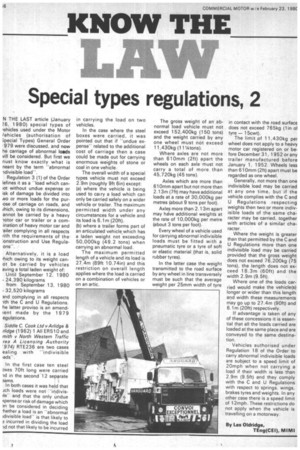Special types regulations, 2
Page 58

If you've noticed an error in this article please click here to report it so we can fix it.
N THE LAST article (January ?6, 1980) special types of 'chides used under the Motor /ehicles (authorisation of ipecial Types) General Order
979 were discussed, and now he carriage of abnormal loads vill be considered. But first we nust know exactly what is leant by the term -abnormal idivisible load-.
Regulation 3 (1) of the Order lefines it as a "load which canot without undue expense or isk of damage be divided into evo or more loads for the purose of carriage on roads, and ihich, owing to its dimensions, annot be carried by a heavy -iotor car or trailer or a corn
nation of heavy motor car and :ailer complying in all respects eith the requirements of the :onstruction and Use Regula ons".
Alternatively, it is a load ,hich owing to its weight canot be carried by vehicles aving a total laden weight of: Until September 12, 1980 24,390 kilograms
from September 13, 1980 32,520 kilograms 3nd complying in all respects ith the C and U Regulations. he latter proviso is an amendlent made by the 1979 egulations.
Siddle C. Cook Ltd v Arlidge & rlidge (1962) 1 All ER510 and mith v North Western Traffic rea A Licensing Authority ' 974) RTE236 are two cases ealing with ''indivisible 'ads''.
In the first case ten steel axes 70ft long were carried id in the second 12 separate 3ams.
In both cases it was held that ich loads were not "indivisileand that the only undue Kpense or risk of damage which 3 n be considered in deciding fiether a load is an "'abnormal 'divisible load' is that likely to 3 incurred in dividing the load id not that likely to be incurred
in carrying the load on two vehicles.
In the case where the steel boxes were carried, it was pointed out that if "undue expenserelated to the additional cost of carriage then a case could be made out for carrying enormous weights of stone or coal in one vehicle.
The overall width of a special types vehicle must not exceed 2.9m (roughly 9ft 6in) except: (a) where the vehicle is being used to dairy a load which can only be carried safely on a wider vehicle or trailer. The maximum permitted width under any circumstances for a vehicle and its load is 6.1m (20ft).
(b) where a trailer forms part of an articulated vehicle which has a laden weight not exceeding 50,000kg (49.2 tons) when carrying an abnormal load.
The maximum permitted length of a vehicle and its load is 27.4m (89ft 10.74in) and this restriction on overall length applies where the load is carried on a combination of vehicles or on an artic.
The gross weight of an abnormal load vehicle must not exceed 152,400kg (150 tons) and the weight carried by any one wheel must not exceed 11,430kg (111/4tons).
Where axles are not more than 610mm (2ft) apart the wheels on each axle must not carry a total of more than 45,720kg (45 tons).
Axles which are more than 610mm apart but not more than 2.13m (7ft) may have additional loads at a rate of 30,000kg per metres (about 9 tons per foot).
Axles more than 2.13m apart may have additional weights at the rate of 10,000kg per metre (about 3 tons per foot).
Every wheel of a vehicle used for carrying abnormal indivisible loads must be fitted with a pneumatic tyre or a tyre of soft or elastic material (that is, solid rubber tyres).
In the latter case the weight transmitted to the road surface by any wheel in line transversely must be such that the average weight per 25mrn width of tyre in contact with the road surface does not exceed 765kg (1 in oi tyre — 15cwt).
The limit of 11,430kg per wheel does not apply to a heavy motor car registered on or before December 31, 1952 or any trailer manufactured before January 1, 1952. Wheels less than 610mm (2ft) apart must be regarded as one wheel.
Generally, not more than one indivisible load may be carried at any one time, but if the vehicle complies with the C and U Regulations respecting weights then two or more indivisible loads of the same character may be carried, together with articles of a similar character.
Where the weight is greater than that permitted by the C and U Regulations more than one indivisible load may be carried provided that the gross weight does not exceed 76,200kg (75 tons), the length does not exceed 18.3m (60ft) and the width 2.9m (9.5ft).
Where one of the loads carried would make the vehicle(s) longer or wider than this length and width these measurements may go up to 27.4m (90ft) and 6.1m (20ft) respectively.
If advantage is taken of any of these concessions it is essential that all the loads carried are loaded at the same place and are conveyed to the same destination.
Vehicles authorised under Regulation 18 of the Order to carry abnormal indivisible loads are subject to a speed limit of 20mph when not carrying a load if their width is less than 2.9m (9.5ft) and they comply with the C and U Regulations with respect to springs, wings, brakes tyres and weights. In any other case there is a speed limit of 12mph. These restrictions do not apply when the vehicle is travelling on a motorway.
By Les Oldridge, TEng(CEI), MIMI




































































































































